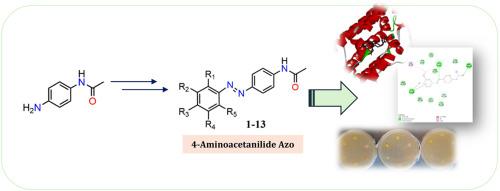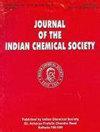Preparation, in vitro and in silico antioxidant and antibacterial studies of 4-aminoacetanilide azo derivatives
Abstract
A new series of new 4-aminoacetanilide azo derivatives 1–13 were successfully synthesised via a diazo coupling reaction and gave a good to excellent yield of 73 %–93 %. The antioxidant capabilities of the series 1–13 screened through 2,2′-diphenyl-1-picrylhydrazyl (DPPH) assay and ferric reducing antioxidant power (FRAP) assay showed promising data of 12.6–199.4 ppm and 12.65–210.9 mg/ml Trolox equivalent, respectively. The findings supported by in silico docking analysis targeted Heme oxygenase-1 (HO-1) evidenced by a binding score of – 7.2 to – 8.2 kcal/mol outperforming the standard, ascorbic acid scoring only – 5.7 kcal/mol. Among all, compound 11 displayed the highest antioxidant potential with IC25 of 12.6 ppm against DPPH assay and 210.9 mg/ml Trolox for FRAP assay believed owing to the presence of methoxy group at ortho position in the phenolic compound that effectively lowered the ionisation potential and high up energy of highest occupied molecular orbital (HOMO). Nevertheless, the antibacterial potential of the series screened through the Kirby-Bauer disc diffusion method against Escherichia coli and Staphylococcus aureus showed no antibacterial activity postulated due to the presence of amide and acetyl group restricted the ability of the compound to form an interaction with the protein receptor of bacteria tested. This study provided new insight into the development of dual-functional drugs for non-communicable diseases and antimicrobial resistance.


 求助内容:
求助内容: 应助结果提醒方式:
应助结果提醒方式:


